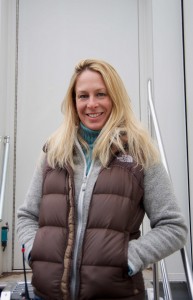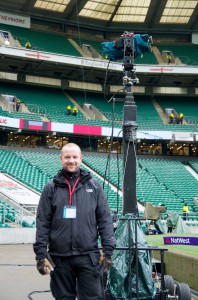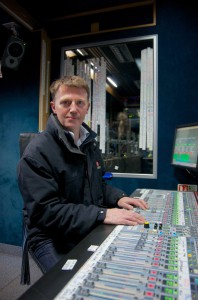Live from Six Nations Rugby: BBC Sport and Telegenic team up for England-Italy
For the 6 Nations, the BBC is host broadcaster for Twickenham, Murrayfield and the Millennium Stadium, while at the other three stadia (in Paris, Rome and Dublin) it does an add-on broadcast, with its own presentation/commentary team and cameras. Although it never has three host matches on a weekend, it does sometimes have two (as it did last weekend with London and Edinburgh). “On any weekend we’ve always got three operations on the road,” said Paul Davies, BBC Sport executive producer and match director at Twickenham.
“At Twickenham every second year you get all the blue teams visiting, France Scotland and Italy, as this year, and you plan accordingly,” he adds. “We’re working with a new OB provider (Telegenic) — the first time we’ve worked with them here at Twickenham. They did the Autumn Internationals for us, off the back of our [previous] relationship with SIS Live, and that’s gone brilliantly well. We’ve done live matches with Telegenic at Cardiff and Murrayfield, and this is our first time at Twickenham, but they are no strangers to it as they do all the live matches with Sky and BT, and they’ll be doing the World Cup [with ITV] as well, so they are very familiar with the venue and with rugby. There are no issues there, and they’ve done a fantastic job for us.
“Twickenham is a great venue to work in. The RFU continues to revamp its facilities for this year’s World Cup, including installing new camera platforms, such as the one above the tunnel area, which now accommodates three camera positions. It is also easy to install specialist cameras, such as Spidercam and Jibs, something which is more challenging at the Millennium Stadium, because it’s such a tight arena.”
Every stadium across the 6 Nations has a unique atmosphere; at Twickenham though, the extra space around the pitch makes it easier to visually capture the communal singing and crowd reactions, really bringing the match ambiance into the home.
The BBC has three matches at Twickenham this season, all with the same camera plan, deploying “the full artillery of kit,” including Spidercam and Towercam, which runs behind the South goal on a rail. “It gives ever-changing height options, so it’s ideal for conversions and penalties, and because it tracks, it can position itself directly in line with the kick, delivering the definitive angle on every kick,” said Davies. He always wants a camera in line with a kick, whether behind the kicker or behind the posts. Unless it’s about distance, for a penalty from the halfway for example, he doesn’t want a side-on shot of the kick, “because it’s all about the line.”
The Towercam XL (its largest model) extends to 10m, and was on a 35m track, on a large MovieBird base (as usually used on a Technocrane). Previously the BBC used a smaller Towercam XM on a wheeled base. “We’ll follow the action and get a different perspective, and can also get a great tracking crowd shot,” said Peter Childs, Towercam technician.
The camera can rotate 360º in about 1.5 seconds at full speed, but is always used at slower speeds on air, and can elevate at about 1m per second. It was fitted with a Sony HDC-1500 with a 14:1 zoom lens. They previously used a 22:1 zoom, but the director preferred 14:1 because it can get a nice wide angle shot as well.
The ever-changing height of the Towercam can “make the experience less two dimensional,” said Davies. It is also ideal for crowd shots, taking in different levels, as is the jib. The jib has an almost 8m arm, so it “can be equally dynamic and powerful,” and “has free range to exploit the crowd shots, as well as to focus on the play in that corner. If you’ve got rucks or mauls, you can really drop down and show the geography of where they are.”
On the wire
Childs also helped to set up the Spidercam, which can be rigged at Twickenham in about six hours, because there is easy to access to the four winches, one in each corner. “We can fly all around the stadium,” said Spidercam pilot, Joe Krugmann. “We are a bit limited by the goal posts, but usually we can go anywhere with the camera, from ground zero to 25m, and we can fly above the poles.”
While following a conversion, Spidercam can fly up at 9m per second. It uses fibre optic cables, for data and pictures, with slip rings allowing it unlimited turns, while its batteries last at least six hours. “We can be in the game with this camera system and give the viewers different angles that are normally not possible otherwise,” added Krugmann.
The Spidercam can be a challenge to install in some stadia, such as the Millennium, and, “like the Ref Cam, needs to be used judiciously,” said Davies. He rarely uses it when the ball is in play, preferring to use if for scrums or to follow kicks, although he did even use it for a top-down view of a line out during the England-Italy match. “The changes of direction are such that it is very hard to cut back to the main cameras. It is very jarring for the viewer to suddenly change angle, and disorientating, and we get quite a lot of complaints, even when we use it cautiously.”
He treats it very much as an atmospheric camera, that is great for the ceremonial pre-match sequences, for locating play on the pitch, or for dropping in to top shots of the scrum, which the expert commentators like for analysis. “It is fantastic for the kicks, because it can drop right behind the kicker. It can then take off and fly with the ball, to see it go through the posts.”
The BBC also used four RF cameras at Twickenham, including one Steadicam, two hand-held cameras (one that runs the whole length of the reverse side of the pitch, the other sharing the main camera side with the Steadicam), and he has recently introduced a fourth hand-held camera dedicated to getting crowd reaction shots.
“These big occasions, you want to exploit the great atmosphere and some of the beautiful shots a camera like that, if you give him a free roaming role, can deliver,” including “the spontaneity of being able to cut straight from a player sliding across for a try,” he explained. “It’s about isolating cameras for specific roles, and if you know that camera’s going to be on a great crowd reaction, you can really heighten the viewer experience by cutting instantaneously to a crowd erupting, so it’s not just the audio you’re hearing, you’re getting the visuals as well. You don’t want to miss the player reactions, but its similar to many sports where you now see a dedicated camera on the coaches, and you’ll see that reaction maybe in replay, but I think to capture that live as a sequence is very powerful.”
Presentation on the double
Davies was the match director for the international feed, but also worked closely with the BBC’s presentation truck, which had its own three cameras (for use in the studio and beside the pitch), but before the match he also rehearsed various moves for the domestic feed, particularly for the pre-game build up, as some of the main cameras switched between international and domestic for certain shots.
“What we absolutely can’t do is compromise the host world feed in any way, and the golden rule of that is don’t put anything on that feed that might embarrass an overseas broadcaster. That includes people in vision and specific BBC graphics,” but during the half-hour build up to the match, he looks at what he can offer the BBC production, such as using the jib camera for a different perspective on the pitch-side presentation, or using the Spidercam on a pre-recorded link. “It’s all about maximising what we have on site, if it doesn’t interfere with the host coverage.” He can also give them a camera during the live coverage, if there’s a break in play, so the Spidercam may be taken by the other truck for a shot of the commentators.

Sue Bourne: “Compared to most rugby coverage there are more cameras, more toys, more EVS systems and graphics”
Having both match and presentation operations, two directors and two trucks (the almost identical T19 and T21), “doubles pretty much everything up engineering wise,” and compared to most rugby coverage there are more cameras, more toys (like Spidercam), more EVS systems and graphics, said Telegenic unit manager, Sue Bourne. “Both trucks are capable of doing the same thing,” but having a separate OB for BBC presentation gives everyone a lot more room. The BBC did the Autumn Internationals out of one truck (with one director), as it did the Rugby League Challenge Cup, although there the “match director and pres director swapped positions, but for this they need to concentrate on their own areas.” With the extra build up, there is a lot more for the presentation team to cover.
“We are doing some [such as at Murrayfield on Sunday] where we’re doing [presentation and match] out of one truck, but have a small world feed van,” for cut and audio mix, but the plans for which matches will have twin trucks or one-plus-van may change as the competition progresses, as the BBC may decide to prioritise the match that has the most editorial impact.
The cameras and general facilities will be comparable whichever mix is used, but the two trucks allow greater comfort and flexibility, so while it may seem like the set up is more complex, “actually, it’s probably easier as you’re not trying to cram everything into one truck, so you have a lot more capacity.” Besides, “the trucks are really powerful, so we have a lot of scope to do what we need to,” she said.
A sound strategy
Sound plays a crucial role in building the atmosphere, and “Twickenham is a stadium that’s fully rigged for television, so we have fibre and copper connectivity, which makes life very easy for us,” said Andy James, senior sound supervisor, BBC Sport. “We have fibre stageboxes all around the ground, from where we can bring back multiple sources. We have remote mic gain of all our microphones in the stadium.”
As he was doing a 5.1 surround sound mix, there was also a Soundfield microphone -positioned just below the commentary position to pick up a high, wide ambiance, with additional crowd mics behind both goals, in lower positions, to cover any shots of the crowd singing at either end. There were also effects microphones on all the radio cameras, “so that when they get in close on the action, we’ve got the effects to go with it. That’s especially important at the beginning of the match, when the teams are in the tunnel and we need to get the effects from there.” It also helps during the singing of the anthems, when there are close ups of the players, to hear them sing too — “sometimes not too much, if they’re not fantastic singers, but it’s nice to get a little of that perspective in as well,” said James.
There are also public address feeds, for pre-match entertainment, and all the commentary mics — four commentators, with lip mics, and an analyst on a head set, to give him more freedom to move. The lip ribbon mic is still the microphone of choice because of its rejection of ambient sound. “You can get a cleaner commentary voice on a lip mic than anything else.”
The pitch side interviewer (in this case Sonja McLaughlin) also had a radio mic, and the Calrec desk also had feeds for the various international broadcasters if they wanted to do their own pitch side interviews on a unilateral feed. “We also service the international commentators as well,” with Italian, French and Irish feeds sent clean from the commentary box to the broadcaster.
“All of Telegenic’s fleet have a Calrec Apollo, which is a very flexible, sophisticated desk, which means we can do almost anything we want. There are plenty of outputs to feed different broadcasters. You couldn’t wish for anything better. This is the best you can get in the OB market. In the OB world, you’re generally tight for space, so you have to have a compact surface — 48 faders, which is enough for a rugby match; plenty of layers,” he said. “It gives me the ability to keep bringing back the viewer and the listener right into the action. So, the more sources I have to hand, the better I can achieve that.”
The XFiles
The production had six LSMs in the match truck (with eight replay lines), and three LSMs for the presentation truck. There were four 3x slow motion cameras, and two 2x slo-mo cameras, plus one Hi-Motion camera (running at 6x – 300fps).
It also recorded all the media on to EVS XFile drives, for archive (as both match clean and transmission output), “but also all angles of the tries,” along with high-speed camera output and interviews, complete with clipping structure, explained Andrew Jackson, freelance VT supervisor. “When all the media gets back to Salford, the librarians can look at it and easily place it in their system.”
There were 42 record chains, including six for the Hi-Motion. “It might sound like a lot of record chains, but it quickly gets eaten up,” he added, with three for the 3x cameras and two for each 2x camera. They could stream six channels at once on to the XFile drives, but it would get slow. “Two is a nice rate, three is OK,” but when there is a lot of background clipping in progress, there is a lot of demand on the bandwidth and the transfer rate slows down.


